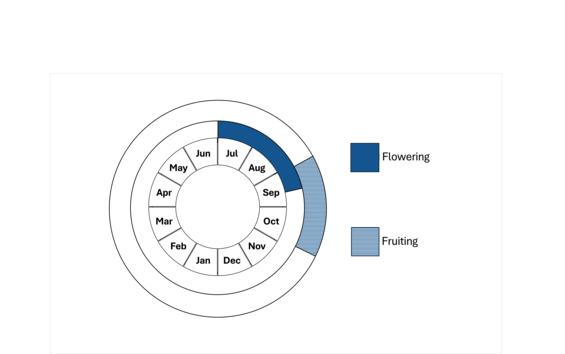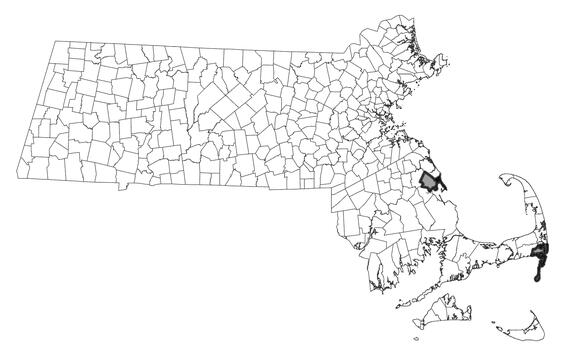- Scientific name: Persicaria setacea
- Species of Greatest Conservation Need (MA State Wildlife Action Plan)
- Threatened (MA Endangered Species Act)
Description
Swamp smartweed is a robust, semi-aquatic, perennial species in the knotweed family (Polygonaceae) with unbranched or sparingly branched stems. It grows erect to 0.4-1.5 m tall (1.3-4.9 ft), with greenish-white or green flower clusters. The common name refers to the many fine whitish hairs that are appressed to the stem (“strigose”) and cover the leaves. This species spreads vegetatively via elongate horizontal rhizomes.
A technical manual should be used to identify swamp smartweed and other Persicaria species. In swamp smartweed, the cylindric ocrea (sheath at the stem formed from the stipules) is thickly covered in hairs and fringed with long, stout bristles. The leaves are lanceolate to oblong-lanceolate and pointed at both ends, with short petioles. The flower clusters are raceme-like and terminal.
Persicaria setacea can be difficult to distinguish from P. hydropiperoides, but it is usually larger and more upright. The flowers of P. setacea are greenish-white, while those of P. hydropiperoides typically have a pinkish hue. The two species can be distinguished more definitively by careful examination of the hairs on the upper leaf-surface and ocreae. In P. setacea, the hairs are fused to the ocreae for up to one-third their length. In P. hydropiperoides, the hairs are fused for one-third to two-thirds their length. The hairs of P. setacea are conspicuously enlarged at the base, while in P. hydropiperoides the hairs are gradually enlarged to the base.
Life cycle and behavior
This is a perennial species.

Population status
Swamp smartweed is listed under the Massachusetts Endangered Species Act as threatened. All listed species are protected from killing, collecting, possessing, or sale, and from activities that would destroy habitat and thus directly or indirectly cause mortality or disrupt critical behaviors. Swamp smartweed is currently known from Barnstable County, and was found historically in Hampden, Plymouth, and Nantucket Counties.
Distribution and abundance
Swamp smartweed occurs across the eastern United States south to Florida, and west to Michigan, Oklahoma, and Texas. It is also found in Washington. It is rare in Massachusetts, New York, Indiana, Ohio, and Pennsylvania, and is considered to be historic in Rhode Island. This species also occurs in Canada from Quebec to British Columbia, and south into South America.

Distribution in Massachusetts. 2000-2025. Based on records in the Natural Heritage Database.
Habitat
In New England, swamp smartweed is found on sandy to peaty pond shores, in moist thickets, and in shallow emergent marshes. Periodic flooding or high water, and saturated or moist soils, are crucial for this semi-aquatic species. It is generally found in acidic but somewhat fertile soils.
Healthy habitats are vital for supporting native wildlife and plants. Explore habitats and learn about conservation and restoration in Massachusetts.
Threats
Alteration of hydrological conditions and changes in nutrient inputs and water quality should be avoided at sites supporting swamp smartweed. This species may be threatened by establishment of dense woody vegetation; extant populations should be monitored for both native and non-native competitors.
Conservation
If needed, a plan should be developed to remove invasive plants in consultation with the Natural Heritage & Endangered Species Program, to reduce or eliminate competing species. In addition, disturbance to pond shores should be avoided to prevent conditions that encourage the establishment of non-native species. All active management of state-listed plant populations (including invasive species removal) is subject to review under the Massachusetts Endangered Species Act and should be planned in close consultation with the MassWildife’s Natural Heritage & Endangered Species Program.
References
Gleason, H. A., and A. Cronquist. 1991. Manual of Vascular Plants of Northeastern United States and Adjacent Canada, 2nd edition. The New York Botanical Garden, Bronx, NY.
Haines, A. 2011. Flora Novae Angliae – a Manual for the Identification of Native and Naturalized Higher Vascular Plants of New England. New England Wildflower Society, Yale Univ. Press, New Haven, CT.
USDA SCS. 1989. Midwest Wetland Flora: Field Office Illustrated Guide to Plant Species. Midwest National Technical Center, Lincoln, NE.
Contact
| Date published: | May 1, 2025 |
|---|